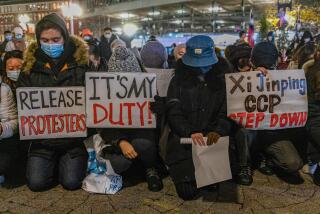Flowers, Floats Brighten Beijing in Festive Holiday Rites
- Share via
BEIJING — Tens of thousands of Chinese celebrating their National Day holiday poured into Tian An Men Square on Thursday, turning this city’s great central plaza into a virtual amusement park.
Set up in the square were flower-and-plant models, similar to floats for Pasadena’s annual Rose Parade, depicting famous sites including the Great Wall, a boat on which the first Chinese Communist Party Congress was held in 1921 and a pagoda at the old revolutionary base of Yanan.
Picture-taking in front of these replicas or against the background of the monumental buildings surrounding the square was the favorite activity for those with cameras, a growing minority in today’s China.
A few groups gathered to play board games or cards, but most people simply strolled with family or friends, enjoying the special decorations on a perfect autumn day.
Workers used about 200,000 potted flowers and plants to make the decorations in the square, while another 800,000 were placed along main streets and boulevards, according to the official New China News Agency.
There were no organized public events in the square, although about 20,000 Beijing residents attended an invitation-only party in the adjacent Great Hall of the People, the news agency reported. National Day parades are now scheduled only once every five years, with the next one set for China’s 40th National Day, in 1989.
Red banners and huge Chinese lanterns decorated Tian An Men (Gate of Heavenly Peace) at the north side of the great square where Chairman Mao Tse-tung stood on Oct. 1, 1949, to declare the establishment of the People’s Republic of China.
At dusk, lights limned the roof lines of the gate, the Great Hall of the People, the Bank of China, Mao’s mausoleum and other buildings around or in the square. Many other buildings throughout the city were similarly decorated.
Mao’s portrait, seldom seen now in a China more interested in economic development than class struggle, still gazes out across the square from the middle of the gate.
For the holiday, however, a portrait of Sun Yat-sen, leader of the 1911 revolution that ousted China’s last emperor, was set up directly opposite Mao’s. Huge portraits of Marx, Engels, Lenin and Stalin, flanked by red banners, were also set up, at the north edge of the square, in keeping with the revolutionary tradition of National Day celebrations.
But this year a new symbol of China’s economic reform and opening to the outside world is in place at the opposite end of the plaza: a three-story, 500-seat Kentucky Fried Chicken restaurant due to open next month. Like the other buildings around the square, its roof line was outlined with white lights.
As crowds began to head home in pedestrian waves barely controlled by special teams of traffic police, huge red neon lights mounted against a flashing blue background on the walls next to the Gate of Heavenly Peace bore the message of the day: “Vigorously develop China; long live the motherland.”
More to Read
Sign up for Essential California
The most important California stories and recommendations in your inbox every morning.
You may occasionally receive promotional content from the Los Angeles Times.













